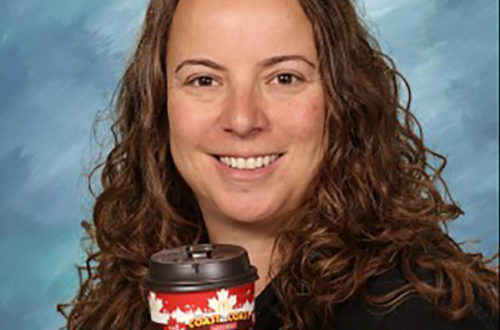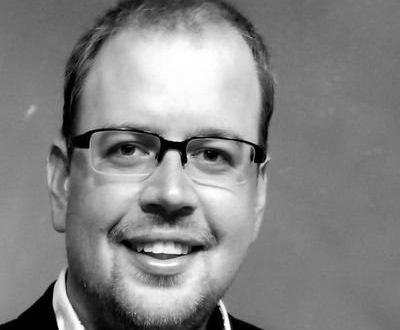Delta-K
Journal of the Mathematics Council of the Alberta Teachers’ Association
Volume 55 Issue 2, March 2019
4 to 8
Ksenya Garaschuk
This article was originally published in CMS Notes 49, no 4 (September 2017), 8-10, and is reprinted with the permission of the Canadian Mathematical Society. Minor amendments have been made in accordance with ATA style.
“Education Notes” brings mathematical and educational ideas forth to the CMS leadership in a manner that promotes discussion of relevant topics including research, activities and noteworthy news items. Comments, suggestions and submissions are welcome. John McLaughlin, University of New Brunswick (johngm@unb.ca); Jennifer Hyndman, University of Northern British Columbia (hyndman@unbc. ca).
While Amy Wooding was finishing her PhD at McGill in number theory, she used to take the train back and forth from Ottawa to Montreal. One day, she was listening to an interview of Peter Diamandis, a founder of the XPRIZE Foundation. He was introducing the upcoming competition for the Global Learning XPRIZE, putting out a challenge to use technology to teach basic literacy and numeracy skills to children who do not have access to teachers. The submitted proposals would be judged and the chosen finalists would then try their software in an 18-month field test with students in Africa. Now that, she thought, would be a really cool project to pursue. She pitched the idea of participation to her husband, Kjell, later that day; he said yes immediately. Two and a half years later, on June 21, 2017, their team, Learn Leap Fly, was named as one of the Global Learning XPRIZE’s 11 semifinalists.
Now, Amy was not just an average person on the train thinking about educational technologies, and Kjell was not just an average guy saying yes to developing them. Both Amy and Kjell Wooding have mixed interdisciplinary backgrounds that are, in many ways, perfect for a project like this. After completing her BSc in math, Amy attended teachers’ college before continuing to her PhD in arithmetic geometry. Kjell started as a computer engineer and then worked in industry before returning to academia to complete his math PhD. Furthermore, within their immediate families they had a plethora of skills required for this project. Among these, Kjell’s family members comprised many educational specialists, while Amy’s aunt runs a children’s home in Kenya.
The intention of this piece is to share more of the experience of the two mathematicians, Amy Wooding (AW) and Kjell Wooding (KW), with a focus on this project. For instance, what challenges did they face and how did they address them? I sat down with them to chat about their project’s past, present and future. As the interviewer, I use my initials (KG) below, with questions and prompts appearing in italics.
KG: So you didn’t have to go very far to find all the necessary skills that one might need for a project like this, but this is still a big undertaking.
KW: I think the thing that helped us the most is that we are both fundamentally researchers. We are people who tackle hard problems for a living. So when it came to this problem, it didn’t seem unusual to try to do a thing that has never been done before. But we also came to it as a blank slate. We came to it not knowing what solution we wanted to see work, just that we wanted to see a solution. Se we came to it very much with a sense of experimentation. We wanted to get in there and try things out, see what was working and what wasn’t.
KG: What was the development process like?
KW: When we started this, there was an 18-month period before you had to submit your solution. So we took that 18-month period and we broke it up into three phases. We called our team Learn Leap Fly, and we ended up doing that as our approach to the problem. First was the Learn phase, where we sat down with educational research to find out the well-known ways to teach literacy and numeracy. Then we started identifying products available already: what software is there now, what does it do well and what does it do poorly? By the end of this phase, we had a pretty good idea about where the challenges were. For the Leap phase, we chose the set of things we wanted to try and started trying them out. We started testing other people’s software to see how children responded to it. We noticed several important things right away, for example that a child’s hand is sometimes too small to do things on the screen the standard way. Some of these discoveries we were making are now obvious in hindsight, but impossible [o know until you do those observations and experimentations. So this was our approach throughout the project: to try things out as soon as possible and see how the children respond. The last phase, the Fly phase, was taking all of our best ideas, all the pieces that worked well, putting them together into a prototype and then flying off to Kenya to try it out with the children there, so we got to see these first interactions with technology.
KG: This is very different, because we now assume that everybody knows how to use a tablet.
AW: Exactly. There are somethings that are assumed that are not natural. Dragging is one of them. It’s a learned thing of how to interact with a mobile device, so now you need to do something design wise to try to teach children to do that.
KW: Design was a huge challenge throughout, for a number of reasons. One of them is when you are trying to appeal to children the world over. Obviously, you have to avoid using a language because they can’t read yet, but you also have to avoid metaphors, because they don’t always work. For example, an icon to go back to the main menu is often a picture of a house. But that doesn’t mean anything to these children, since they have no context for it, so you have to find things that, whenever possible, communicate what you want to do directly. So we had to experiment to see what children would respond to, children who have never seen this technology before and wouldn’t necessarily have any instruction on it.
KG: What other things did the initial testing in Kenya reveal?
KW: Here we have this interesting ideal of one device per child. When we did our alpha testing in Kenya, we had four tablets with us and a dozen children, so of course we would end up with multiple children per tablet. We noticed right away that we weren’t just getting children in the age group we were aiming at, but we were getting everybody. At the same time. AW: This was deliberate on our part, we wanted to test it out naturally. We didn’t want to impose any constraints. We wanted to see what they would do and how they would work together, whether this is something we need to incorporate into our design, something we should focus on or not.
KW: It turned out to be very powerful. Having three to four children per tablet was actually a benefit, because it set up a social environment. Reading, for example. Some of the children knew how to read and some didn’t, but they surely knew how to listen and repeat. So you got this group activity of reading together and even those children who weren’t attracted to the letters wanted to participate in the social part of this. We wanted to play on this social idea. So, whenever possible, we started designing our software so it could be used not just by one child at a time, but by a group of children, all their hands on a tablet, working together.
KG: So it has to be multitouch because there will be a lot of little hands.
KW: Exactly, there might be a dozen hands on the screen or as many as would fit, so your activities needed to accommodate all of those hands. Designing this kind of social software is not well known, well understood or well developed, so this meant rethinking a lot of the ways we typically design our activities.
AW: When we were faced with the problem of doing personalization to groups, we came up with the idea of “digital personalities,” where each tablet has its own distinct personality. It may prefer certain types of activities or stories, whereas the tablet beside it will have different preferences. The first step is to give children the chance to self-select a tablet, but then we also have things that adapt underneath it.
KG: What about the level and progression of activities? Since you cannot rely on the same child working with the same tablet every time, how does the software accommodate that?
AW: There are three main threads: reading, writing and numbers. Some are mixed and matched in the sense that numbers may know what level of reading you are at, so they know whether they should ask you to write the numbers out or not and so on. But it is all driven by a set of stories and every set of activities adapts each time to reflect the story you just read. For vocabulary-building activities, it will pull words from the story. For numbers, it may draw elements of the story and ask you to count them. So the stories control the certain amount of the levelling and allow us to control user preference in the sense that the software can always connect the activities to the elements from your favourite stories. Under the hood, we have a decision engine that keeps track of the user preferences, such as the kinds of stories you like, as well as which level you are on in various activities. To add a little bit of randomness and variation, there is always a distinct aspect of the digital personality present in these decisions. There is also always some notion of curriculum, as in where you are in terms of learning progression.
KW: This is where it’s convenient that we happen to be mathematicians and data scientists. We can use things like machine learning to identify the level we think the children are at and adapt the activities accordingly. But again, we always have to be aware of the fact that we never know for sure if it is the same children coming back. So those digital personalities have to be able to recognize that behaviours have changed and change the way it is acting.
AW: If the software ever feels that the user has changed in a significant way, it goes through an annealing-type process where it presents the child with a whole bunch of random options to quickly figure out their level and preferences. As behaviour stabilizes over time between different groups of users on a particular tablet, it also uses clustering to break up different types of behaviours. So if it expects to see 10 different kinds of behaviours on this tablet, it just has to figure out which one it is currently dealing with.
KG: How does it make sure that children practise various skills, as opposed to just picking one type of activity they are already good at?
AW: At the end of every activity, the main menu has eight choices, so a child always has a choice, but it is how we fill those choices that matters. Some of the choices will be influenced by user preferences and some by curriculum preferences. If the child only ever chooses user preference options, it will eventually be filled with all curriculum choices. So when you are trying to maximize engagement, you will present more user preference-type choices; if the child is highly engaged, the software might decide it is a good time to learn something new and swing toward more curriculum-type choices. It will oscillate back and forth to guide you in various directions.
KG: Your software is driven by a set of stories and it pulls content from them. So if you decide to implement it in another language, you can just upload a new set of stories?
KW: Exactly. One of the great appeals to us in this approach is that it allows us to easily engage with a new language or a new culture, say our northern communities in Canada. We would first work with that community to develop the initial set of stories, so we get some cultural and linguistic familiarity. This aspect of being able to create stories that are culturally relevant to the group is a great way to be able to tailor the content. You start with a set of stories and do the work to separate the characters, objects, story elements and everything adapts.
KG: What is the next step for you?
AW: This fall, we will be in kindergarten classes in Ottawa and will be introducing French content as well. Their curriculum here is 50-50 English and French timewise, which is a recent change, so the teachers are looking for more suitable resources for instruction. So we are working over the summer to get everything in French as well ready to go for the new school year in September.
KW: We were originally developing this software to be used essentially without schools and teachers, but we are also doing our testing in classes and kindergartens and after-school programs. Because it was designed for children at different levels and for children working in groups, it ended up working really nicely in classrooms, where you can set up stations with four or five devices for children to work together. It worked so well in the classroom environment that by the end of the school year we had teachers asking if they can use this in their classrooms on an ongoing basis, which was a pleasant surprise. So we figured, let’s give it a shot. Starting September, we will be working with some classrooms here in Ottawa to align it better with their curriculum to introduce activities that fit with how we do kindergarten here and, again, to bring it closer to home with French and English as a start.
KG: Last question: What has been the most exciting part of this process?
KW: In my opinion, all of the interesting stuff we do in mathematics occurs on the boundary where it meets something else in the world. We never could have predicted when we started out that we will be using machine learning or developing Bayesian inference systems to these digital personalities. But it’s the combination, the ability to take all of these different areas together and put them into one solution that makes it really exciting.
AW: The ability to make a real difference in the world. To apply mathematics and research in a way that can change the lives of hundreds of millions of children. It’s an incredible experience.
Note: Readers interested in more information on the work of Amy and Kjell Wooding may wish to visit learnleapfly.com.
Kseniya Garaschuk is an assistant professor of mathematics and statistics at University of the Fraser, Abbotsford, British Columbia, and can be reached at kseniya.garaschuk@ufvca.





